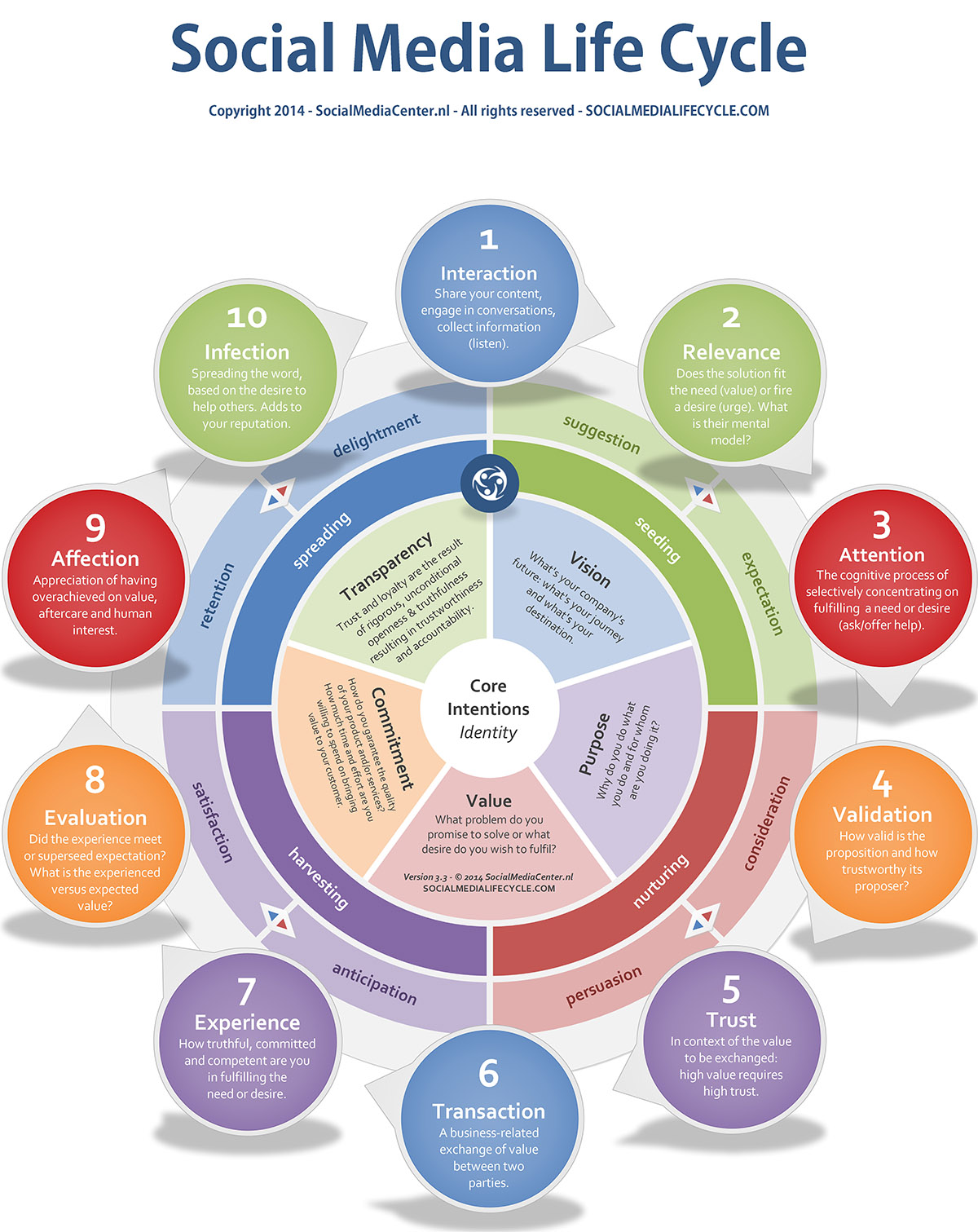Social media marketing starts with relevant content creation and interaction. It ends with affection and transaction.
Like every good (and mostly free) marketing tool, there is going to be competition for attention. You may have asked yourself, “Is it too late? Will our company be left out?” The short answer is no, but you have to understand that everything has a life cycle, and social media a great marketing tool that businesses use to reach their target market.
Today there is no better way to communicate current issues and build brand awareness. Check out this infographic for the fundamental building blocks of social media marketing.
Source: www.socialmediacenter.com
The Social Media Life Cycle
The Social Media Life Cycle is a comprehensive framework for understanding how organizations—or individuals—establish and nurture relationships, deliver value, and ultimately inspire advocacy through social media. At its heart lies a clearly defined identity or Core Intentions, which inform every step of a ten‐stage lifecycle. Encircling those core intentions are intermediate transitional phases (such as suggestion, seeding, expectation, and so on) that bridge high‐level purpose and day‐to‐day actions. Finally, ten numbered stages—from Interaction (Stage 1) through Infection (Stage 10)—describe the progression from first contact to enthusiastic advocacy.
I. Core Intentions (Identity)
At the very center of the diagram is a small white circle labeled:
Core Intentions
Identity
These core intentions, or facets of organizational identity, form the foundation for every activity in the social media lifecycle. They are depicted as five equally sized, color‐coded “slices” radiating outward from the center. Each slice carries a keyword (Vision, Purpose, Value, Commitment, Transparency) and a concise definition of what that concept means in practice.
1. Vision
(light blue slice)
**“What’s your company’s future; what’s your journey and what’s your destination.”_
-
This slice reminds us that, before anything else, an organization must clearly articulate where it is headed. Its vision statement answers the question:
“What direction am I going, and where will I arrive?”
-
Within the social‐media context, having a vision ensures that every post, conversation, video, tweet, or update ties back to a coherent, long‐term aspiration.
2. Purpose
(lavender slice)
“Why do you do what you do, and for whom are you doing it?”
-
Here, “purpose” drills down from the broad horizon of Vision to the more immediate question of motivation and audience. It asks organizations to be explicit about:
• The reasons they exist, beyond simply “making money.”
• The specific groups or communities they serve.
-
A crystal‐clear purpose prevents irrelevant noise on social channels and helps the audience understand “why this matters to me.”
3. Value
(rose‐pink slice)
“What problem do you promise to solve, or what desire do you wish to fulfill?”
-
Every brand, individual, or organization on social media needs to promise— and then deliver—something of tangible or intangible worth.
-
This slice reminds you to articulate the exact need or longing your target audience has, and to articulate how your product, service, or content will satisfy it.
4. Commitment
(peach slice)
“How do you guarantee the quality of your product and/or services?
How much time and effort are you willing to spend on bringing value to your customer?”
-
Making a promise (Value) is only the start; “Commitment” is about the ongoing diligence you will bring to ensuring that promise is kept.
-
It speaks to internal processes, quality assurance, customer‐service philosophy, and the investment of resources (time, money, manpower) required to deliver real value.
5. Transparency
(sage‐green slice)
“Trust and loyalty are the result of rigorous, unconditional openness & truthfulness,
resulting in trustworthiness and accountability.”
-
In social media, no amount of slick marketing can override the audience’s desire for honesty.
-
This slice emphasizes that an organization must be comfortable exposing its processes, decisions, even occasional mistakes— because an unwavering commitment to openness is what turns followers into believers.
II. Transitional Phases (Mid-Ring)
Surrounding these five core‐intention slices is a ring of ten equal arc‐shaped segments. Each segment is labeled by a single keyword (all lowercase) in a dark, narrow font. These transitional phases describe the “middle ground” between internal intentions (Vision through Transparency) and the ten outward‐facing stages of engagement. In sequence (moving clockwise), these ten labels are:
-
suggestion
-
seeding
-
expectation
-
consideration
-
persuasion
-
nurturing
-
anticipation
-
harvesting
-
retention
-
spreading
Finally, bridging from “spreading” back into “suggestion,” there is a small overlapping label:
-
delightment
Below, each transitional phase is reproduced exactly as it appears on the graphic, and no additional descriptions are invented.
1. suggestion
-
Occupies the arc just clockwise of Stage 1 (Interaction) and just before Stage 2 (Relevance).
-
The word is set in olive-green text on a light green background.
2. seeding
-
Occupies the arc between “suggestion” and “expectation,” lying just beneath Stage 2 (Relevance).
-
The word is set in white text on a mid-green background.
3. expectation
-
Occupies the arc just before Stage 3 (Attention).
-
Text in olive-green on a pale‐green background.
4. consideration
-
Occupies the arc just before Stage 4 (Validation).
-
Text in deep red on a light‐pink background.
5. persuasion
-
Occupies the arc just before Stage 5 (Trust).
-
Set in white text on a muted cranberry background.
6. nurturing
-
Occupies the arc between Stage 4 (Validation) and Stage 6 (Transaction) (i.e., it flows under Stage 5, Trust).
-
Text in white on a darker red background.
7. anticipation
-
Occupies the arc between Stage 6 (Transaction) and Stage 7 (Experience).
-
Text in deep purple on a violet-lavender background.
8. harvesting
-
Occupies the arc between Stage 7 (Experience) and Stage 8 (Evaluation).
-
Text in white on a medium-purple background.
9. retention
-
Occupies the arc between Stage 8 (Evaluation) and Stage 9 (Affection).
-
Set in white on a deep-blue background.
10. spreading
-
Occupies the arc between Stage 9 (Affection) and Stage 10 (Infection).
-
Text in white on a “steel blue” background.
At the final juncture—between Stage 10 (Infection) and Stage 1 (Interaction)—a small overlapping label reads delightment (navy text on a pale-blue background). This floating word straddles the boundary to symbolize the idea that “delightment” feeds back into the earliest phase of driving potential new followers to Interaction.
III. Ten Stages of the Life Cycle
Encircling the transitional phases are ten numbered circles (bubbles), each in a distinct color, with a bold number (1 through 10), a one-word title, and a short explanatory subtitle in white text. Each of these bubbles is connected by a slender gray pointer to its matching transitional arc. In sequence (clockwise), the ten stages are:
Stage 1 – Interaction
(blue circle)
Interaction
“Share your content, engage in conversations, collect information (listen).”
-
At this very first step, the organization (or individual) publishes something (a post, a tweet, an article, a video) and takes time to engage in genuine dialogue.
-
Listening is as important as talking: gather feedback, watch for questions, and note reactions.
Connection to Core Intentions:
-
“Interaction” emerges once you know, from your Vision and Purpose, what you want to say and whom you want to say it to.
-
Within the transitional ring, “Interaction” flows into both suggestion (offering something new to the audience) and spreading (ensuring early sharers can pass on your message).
Stage 2 – Relevance
(light green circle)
Relevance
“Does the solution fit the need (value) or fire a desire (urge)? What is their mental model?”
-
At this point, your audience is asking:
“Is this pertinent to me? Does it solve a problem I have, or ignite a want I feel?”
-
If your message isn’t tightly aligned with their mental model (the way they think about their own challenges or desires), it will be ignored.
Connection to Core Intentions:
-
Relevance must flow directly from your Value slice (“What problem do you promise to solve or what desire do you wish to fulfill?”).
-
Within the transitional ring, “Relevance” is bracketed by suggestion (peer or brand recommending something) and seeding (planting the notion in the audience’s mind).
Stage 3 – Attention
(crimson circle)
Attention
“The cognitive process of selectively concentrating on fulfilling a need or desire (ask/offer help).”
-
Once you have piqued someone’s interest (Relevance), you must earn their focus; attention is a finite resource.
-
This stage is about the moment your audience actually stops scrolling long enough to look at your post, click on your link, or tap “Learn More.”
Connection to Core Intentions:
-
Attention is rooted in your Purpose (“Why do you do what you do and for whom are you doing it?”), since purpose-driven content is more likely to hold attention.
-
Within the transitional ring, “Attention” sits between expectation (the audience is now anticipating a solution) and consideration (they are actively evaluating you).
Stage 4 – Validation
(orange circle)
Validation
“How valid is the proposition and how trustworthy its proposer?”
-
Now that you have someone’s attention, they are asking:
“Is this credible? Are you who you claim to be? Will this really work as promised?”
-
Validation can come from reviews, user-generated content, endorsements, social proof, or transparent case studies.
Connection to Core Intentions:
-
Validation hinges on Transparency, because being open and truthful (even about limitations) often wins more trust than overstated claims.
-
Within the transitional ring, “Validation” is flanked by consideration (weighing options) and persuasion (presenting arguments to tip the decision).
Stage 5 – Trust
(lavender-purple circle)
Trust
“In context of the value to be exchanged; high value requires high trust.”
-
By the time someone has validated you, you either have their trust (to some degree), or you don’t.
-
High-stakes decisions (purchasing a service, entering into a contract) always amplify the need for trust.
-
Trust can be built via transparent terms, clear policies, recognized credentials, or even a well-curated social media presence.
Connection to Core Intentions:
-
Trust grows from Commitment, because delivering consistently on your promises over time cements reliability.
-
Within the transitional ring, “Trust” bridges persuasion (bolstering your arguments with credible proof) and nurturing (continuing the relationship so that trust deepens).
Stage 6 – Transaction
(steel blue circle)
Transaction
“A business‐related exchange of value between two parties.”
-
This is the moment of truth: a sale, a sign-up, a download, or any formal exchange (e.g., giving up an email address for gated content).
-
Transaction requires that both trust and perceived value are high enough for someone to commit.
Connection to Core Intentions:
-
A successful Transaction must honor the promises made under Value (what problem you solve) and Commitment (the quality you’ve guaranteed).
-
Within the transitional ring, “Transaction” is preceded by nurturing (steady relationship building) and followed by anticipation (the customer now expects you to fulfill your promise).
Stage 7 – Experience
(violet circle)
Experience
“How truthful, committed and competent are you in fulfilling the need or desire?”
-
After the transaction, it’s not over. The actual user (or customer) experience— how well you deliver service, support, or product— determines whether satisfaction will occur.
-
This stage is all about execution: shipping on time, providing clear instructions, responding to questions, and so forth.
Connection to Core Intentions:
-
“Experience” lives at the intersection of Commitment (the effort you’ve promised to make) and Transparency (how openly you communicate if there’s a hiccup).
-
Within the transitional ring, “Experience” is supported by anticipation (customer expectation for what’s coming) and feeds into harvesting (you reap data, feedback, social posts about that experience).
Stage 8 – Evaluation
(amber/orange circle)
Evaluation
“Did the experience meet or supersede expectation? What is the experienced versus expected value?”
-
Here, customers or users compare what actually happened to what they thought would happen.
-
Did you deliver more than promised (delight), exactly as promised (satisfaction), or less than promised (disappointment)?
-
Their answer will heavily influence the next stage— whether they become brand advocates or quietly churn.
Connection to Core Intentions:
-
The “Evaluation” stage ties directly back to Value (was the problem solved?) as well as Transparency (if something went wrong, were you honest about it?).
-
Within the transitional ring, “Evaluation” transitions from harvesting (collecting feedback/data) to retention (can you keep this customer?).
Stage 9 – Affection
(deep red circle)
Affection
“Appreciation of having overachieved on value, aftercare and human interest.”
-
Affection arises when the customer genuinely applauds you for going above and beyond. They feel cared for and recognized as human beings, not just as a transaction.
-
Complimentary aftercare, behind-the-scenes stories, small gestures (e.g., a personalized thank-you note) can stoke affection.
Connection to Core Intentions:
-
Affection is the fruit of Commitment (ensuring quality) combined with Transparency (being real and human).
-
Within the transitional ring, “Affection” flows into spreading, because people who feel affection become natural evangelists.
Stage 10 – Infection
(lime-green circle)
Infection
“Spreading the word, based on the desire to help others. Adds to your reputation.”
-
“Infection” is a deliberately positive use of a term often associated with “catching” something—and here it refers to word‐of‐mouth or viral sharing.
-
It means that your existing customers or followers actively broadcast your brand (or message) because they believe it will help their friends, peers, or community.
Connection to Core Intentions:
-
“Infection” loops back to Transparency (since authentic sharing depends on trust) and Value (people will only recommend a genuine solution).
-
Within the transitional ring, “Infection” cooperates with delightment (exceeding expectations) to feed a new wave of suggestion (Stage 1) for people who haven’t yet interacted with you.
IV. The Outer Boundary
Although not labeled explicitly with additional words, the very outer circumference of the diagram ties all ten stages into a closed loop. Each numbered bubble (Stage 1 through Stage 10) is linked by a faint gray line to its corresponding transitional phase(s), and arrows subtly indicate the clockwise flow from one stage to the next—culminating in an always‐present opportunity to reenter Stage 1 (Interaction) for new audiences, reactivate dormant ones, or even reengage existing customers in fresh, deeper ways.
The visual cues are:
-
Each stage’s bubble is offset from—and connected to—the ring of transitional arcs.
-
Thin gray pointers emphasize that “Interaction” comes first, then “Relevance,” then “Attention,” and so on, all the way to “Infection,” which in turn feeds both the “delightment” tag and the “suggestion” tag—looping the cycle back to “Interaction.”
V. Putting It All Together
-
Begin with Identity (Core Intentions).
Without a clear Vision, Purpose, Value, Commitment, and Transparency, none of the downstream stages or transitions can succeed. These five facets declare, in bold terms, who you are and what you stand for. -
Translate Intentions into Transitional Phases.
Once core intentions are established, the “Mid-Ring” activities—suggestion, seeding, expectation, consideration, persuasion, nurturing, anticipation, harvesting, retention, spreading, and finally delightment—form a sequence of marketing-and-engagement tactics that guide prospects from awareness to advocacy. Each keyword on this ring describes exactly how you move someone from one stage of the lifecycle to the next. -
Follow the Ten Stages in Sequence.
The outermost layer—the ten numbered stages—represents the audience’s actual journey:-
Interaction (initial connection) →
-
Relevance (is it meaningful?) →
-
Attention (does it command focus?) →
-
Validation (can they trust it?) →
-
Trust (is there confidence?) →
-
Transaction (will they exchange value?) →
-
Experience (how do you fulfill the promise?) →
-
Evaluation (how did you measure up?) →
-
Affection (did you exceed expectations?) →
-
Infection (will they evangelize it?).
Each stage has its own label and precise definition—presented below exactly as in the image:
-
Interaction
“Share your content, engage in conversations, collect information (listen).” -
Relevance
“Does the solution fit the need (value) or fire a desire (urge)? What is their mental model?” -
Attention
“The cognitive process of selectively concentrating on fulfilling a need or desire (ask/offer help).” -
Validation
“How valid is the proposition and how trustworthy its proposer?” -
Trust
“In context of the value to be exchanged; high value requires high trust.” -
Transaction
“A business‐related exchange of value between two parties.” -
Experience
“How truthful, committed and competent are you in fulfilling the need or desire.” -
Evaluation
“Did the experience meet or supersede expectation? What is the experienced versus expected value?” -
Affection
“Appreciation of having overachieved on value, aftercare and human interest.” -
Infection
“Spreading the word, based on the desire to help others. Adds to your reputation.”
-
-
Loop Back to Begin Again.
Once a member of your audience arrives at Stage 10 (“Infection”), the process is designed to loop back to Stage 1 (“Interaction”)—now not with strangers, but with an enthusiastic advocate who actively seeding and suggesting your content to new potential consumers.
The special transitional word delightment (situated between Stage 10 and Stage 1) emphasizes that the ultimate goal is to deliver such a memorable experience that customers themselves circle back to the very first step: interacting with—or indeed creating—fresh content on your behalf.
VI. Why Every Element Matters
-
Core Intentions (Identity)
-
If your Vision is muddled, you will lack direction across all communications.
-
A purpose that does not resonate means your audience will not care.
-
Vagueness about your Value proposition confuses potential customers.
-
A half-hearted Commitment shows up as poor service or broken promises.
-
A lack of Transparency creates suspicion and obstructs “Validation” and “Trust.”
-
-
Transitional Phases (Mid-Ring)
-
In today’s noisy social-media environment, you cannot simply launch full-throated “sales speak” at Stage 1. You must move people along via suggestion, then seeding, expectation, and so on—layering social proof, content marketing, and relationship building at each stage.
-
Each keyword in the mid-ring is a conscious callout to the tactics you deploy on that “gentle slope” between the inner identity and the outer transactional stages.
-
-
Ten Stages (Outer Ring)
-
A “push-only” or “spray‐and‐pray” approach that skips stages will fail, because your audience will not trust or value what you have to offer.
-
By explicitly naming each stage—Interaction, Relevance, Attention, Validation, Trust, Transaction, Experience, Evaluation, Affection, Infection—you are able to measure progress, identify bottlenecks, and double down on the right interventions.
-
Once someone becomes an advocate in Stage 10 (“Infection”), they actually widen your potential to reach more people, which restarts the entire cycle with fresh eyes in Stage 1 (“Interaction”).
-
VII. Final Thoughts
Together, these elements form a closed‐loop system:
-
Core Intentions anchor who you are.
-
Transactional Phases describe how you move from private intentions to public engagement.
-
Ten Stages map exactly what your audience is thinking, feeling, or doing at each moment.
By adhering strictly to each labeled element—using the exact definitions and sequence provided—organizations can build, measure, and repeat a social‐media strategy that is coherent, defensible, and capable of transforming casual observers into vocal advocates.
Social Media Life Cycle
Copyright 2014 – SocialMediaCenter.nl – All rights reserved – SOCIALMEDIALIFECYCLE.COM
About The Author
Marketing Team
The AOK Marketing Team is a diverse group of amazing individuals driven to help all of our clients succeed. Great people are everywhere, and we believe that people should control their workday, their work environment, and where they live. We have team members in 9 countries: United States, Canada, Egypt, Belgium, Ireland, Australia, India, Pakistan, and Hong Kong.
How can we help you?





